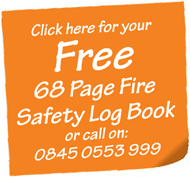Fire Evacuation and Emergency Plan
FIRE EVACUATION AND EMERGENCY PLAN
You will need to plan the action that your employees and other people in the workplace should take in the event of a fire. If you employ more than five people then you must have a written emergency plan. This emergency plan should be kept in the workplace, be available to your employees and the employees’ representatives (where appointed) and form the basis of the training and instruction you provide. Any written plan should be available for inspection by the fire authority.
The purpose of the emergency plan is:
• to ensure that the people in your workplace know what to do to if there is a fire; and
• to ensure that the workplace can be safely evacuated.
In drawing up the emergency plan, you need to take the results of your risk assessment into account.
For most workplaces it should be easy to prepare a reasonable and workable emergency plan. In some small workplaces the final result may be some simple instructions covering the above points on a Fire Action Notice. However, in large or complex workplaces, the emergency plan will probably need to be more detailed.
If your workplace is in a building which is shared with other employers or occupiers, the emergency plan should be drawn up in consultation with those employers and the owner(s) or other people who have any control over any part of the building. It can help to agree on one person to co-ordinate this.
Your plan should provide clear instructions on:
• the action employees should take if they discover a fire;
• how people will be warned if there is a fire;
• how the evacuation of the workplace should be carried out;
• where people should assemble after they have left the workplace and procedures for checking whether the workplace has been evacuated;
• identification of key escape routes, how people can gain access to them and escape from them to places of safety;
• the fire-fighting equipment provided;
• the duties and identity of employees who have specific responsibilities in the event of a fire;
• arrangements for the safe evacuation of people identified as being especially at risk, such as contractors, those with disabilities, members of the public and visitors;
• where appropriate, any machines/processes/power supplies which need stopping or isolating in the event of fire;
• specific arrangements, if necessary, for high-fire-risk areas of the workplace;
• how the fire brigade and any other necessary emergency services will be called and who will be responsible for doing this;
• procedures for liaising with the fire brigade on arrival and notifying them of any special risks, eg the location of highly flammable materials; and
• what training employees need and the arrangements for ensuring that this training is given.
If you have a larger or more complex workplace, then it might be helpful to you to include a simple line drawing. This can also help you check your fire precautions as part of your ongoing review. The drawing could show:
• essential structural features such as the layout of the workplace, escape routes, doorways, walls, partitions, corridors, stairways etc (including any fire-resisting structure and self-closing fire doors provided to protect the means of escape);
• means for fighting fire (details of the number, type and location of the fire-fighting equipment;
• the location of manually operated fire alarm call points and control equipment for the fire alarm;
• the location of any emergency lighting equipment and any exit route signs;
• the location of any automatic fire-fighting system and sprinkler control valve; and the location of the main electrical supply switch, the main water shut-off valve and, where appropriate, the main gas or oil shut-off valves.
The Fire Emergency Plan must be reviewed periodically where appropriate.
Disclaimer: This plan is for advice purposes only and any plan created must be done in accordance with your fire risk assessment.




Leave a Reply